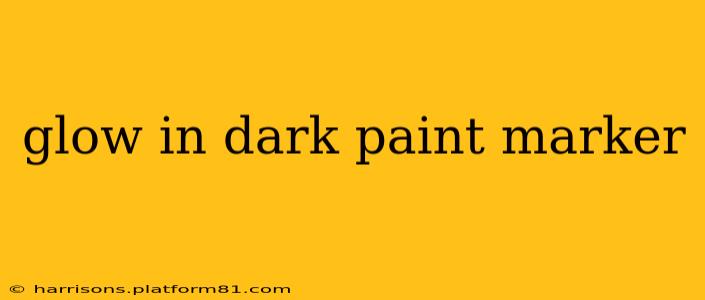Glow-in-the-dark paint markers are a fun and versatile tool for adding a unique touch to various projects. Whether you're crafting, decorating, or marking items for visibility in low-light conditions, these markers offer a creative and practical solution. This guide delves into the intricacies of glow-in-the-dark paint markers, exploring their uses, types, and considerations for optimal results.
What are Glow-in-the-Dark Paint Markers?
Glow-in-the-dark paint markers contain a luminescent pigment, typically a phosphor, that absorbs light and then re-emits it over time. This process, called phosphorescence, allows the paint to "glow" in the dark after being exposed to a light source, such as sunlight, UV light, or a regular incandescent bulb. Unlike fluorescent paints which require a continuous light source, phosphorescent paints continue to glow for a period after the light source is removed, although the intensity gradually diminishes.
What are Glow-in-the-Dark Paint Markers Used For?
These versatile markers find applications in diverse fields:
- Arts and Crafts: Decorate canvases, pottery, fabrics, wood, and more.
- DIY Projects: Enhance home décor, personalize items, and create unique designs.
- Safety Marking: Clearly mark pathways, equipment, or emergency exits in low-light environments.
- Kids' Activities: Fun for children's crafts, nighttime games, and imaginative play.
- Model Making: Add realistic details to scale models and dioramas.
- Party Decorations: Create glowing accents for birthday parties, Halloween events, or other celebrations.
What Types of Glow-in-the-Dark Paint Markers are Available?
The market offers a variety of glow-in-the-dark paint markers, differing in:
- Pigment Type: Different phosphors offer varying glow durations and brightness. Some may glow brighter but for a shorter time, while others offer a longer, less intense glow.
- Tip Size: From fine points for detailed work to broader tips for covering larger areas.
- Ink Viscosity: Thicker inks are suitable for textured surfaces, while thinner inks are ideal for smoother surfaces and fine lines.
- Color: While most are white or a pale yellowish-green, some manufacturers offer colored options that glow after being charged with light.
How Long Do Glow-in-the-Dark Paint Markers Glow?
The duration of the glow depends on several factors, including the type of phosphor used, the intensity of the charging light, and the surrounding environmental conditions. Generally, you can expect a glow lasting from several minutes to several hours after charging. For the brightest and longest-lasting glow, ensure the markers are fully charged under a bright light source for a sufficient amount of time.
How to Make Glow-in-the-Dark Paint Markers Glow Brighter and Longer?
To maximize the glow, follow these tips:
- Charge Thoroughly: Expose the painted surface to a strong light source for at least 30 minutes. UV light is particularly effective.
- Use a Bright Light Source: The brighter the charging light, the more intense and longer-lasting the glow will be.
- Avoid Direct Sunlight (for some paints): Prolonged exposure to direct sunlight can degrade some phosphors over time, reducing their glow intensity.
What Surfaces are Suitable for Glow-in-the-Dark Paint Markers?
Most glow-in-the-dark paint markers adhere well to a variety of surfaces including:
- Paper
- Wood
- Glass
- Plastic
- Canvas
- Metal (some preparation may be needed)
- Fabric (some preparation may be needed)
Always test the marker on a small, inconspicuous area first to ensure compatibility and desired results. The surface's texture and porosity will influence how well the paint adheres and glows.
Are Glow-in-the-Dark Paint Markers Toxic?
Reputable brands generally use non-toxic, child-safe pigments. However, always check the product's label for specific safety information and follow the manufacturer's instructions. Avoid direct contact with eyes and skin. Ensure proper ventilation when using the markers.
Can you Mix Glow-in-the-Dark Paint Markers with Other Paints?
Mixing glow-in-the-dark paint with other paints is possible, but it will dilute the glowing effect. The intensity of the glow will diminish depending on the ratio of glow paint to the other paint. Experimentation is key to finding the optimal balance between color and glow.
By understanding these factors and following best practices, you can harness the full potential of glow-in-the-dark paint markers and create truly spectacular and eye-catching results.
